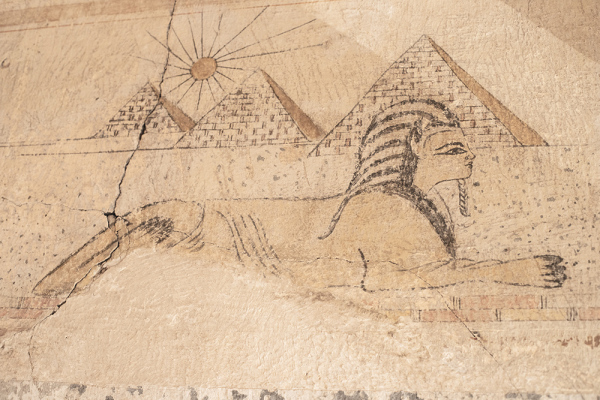-

The Cat of Padure, watercolor and goache on plaster, 2023.
Reference to the most common souvenir papyrus drawing of the Giza pyramids and Sphinx.
Group show 'Decentrality' at Padure manor, Latvia, 2023.
.
Can periphery become an attractive center of attention, almost equal to the places where the population, as well as any other processes, are already so closely packed and overlapped countless times? Does the habit of filling one spot complicates willing deviations from the center, scattering and separation?
The central topics of the exhibition includes questions about the relationships between the center and province, the possibility of shifting the centers of attention and their potential decentralization. Moving to and from places where culture and art events are concentrated, at the same time being aware that there is an environment that invites with its seemingly uncrowded space, authors are observing, marking trajectories and challenges periodic circulations, they are returning to the Padure manor in Latvian countryside again or arriving here for the first time.
Padure manor offers the opportunity to make contact with the works of art in a leisurely way, longer than a usual exhibition visit. Meeting with the work of art can be extended over several days. The visitor is invited to share his living space with exhibition, his gaze is allowed to wander from one point to another, or focus on some interior details. Does the environment become a residence for art and its consumer, thus inverting the idea of an artist residency?
.
Artists: Luīze Rukšane, Rūdolfs Štamers, Karlīna Mežecka, Inga Meldere, Atis Jākobsons, Pēteris Sīlis, Anna Malicka, BmwAudi, Hele, Pauls Rietums, Marta Viktorija Agruma and Annemarija Gulbe.
.
Curator and photography: Annemarija Gulbe
****
-
The fictional story of the executed wall painting is based on some 19th-century* female traveller's*** visual travel notes. At a time when "the conviction that travelling broadens the horizon, increases knowledge and breaks down the boundaries between social orders, nationality and also genders!"**
The "central" visual, adapted to the skills and aesthetic sense of the local unknown painter from Kurzeme, becomes locally comprehensible. The majestic expressiveness of the Egyptian sphinx seen in travels finds reference in the independence of the local domestic animal - cat. Archaeological clay sherd artefacts in Pompeii, Italy, are reflected in the outlines of the decorative coverings of Padure pottery pots. The author both reveals and conceals. The periphery becomes the centre.
.
* the time when the Padure manor was built
.
** Kārkla Z. In memory of Minnas Freimane road descriptions 1884. LU Academic publication, 2020. /Kārkla Z. Par piemiņu Minnas Freimanes ceļa apraksti 1884. LU Akadēmiskais apgāds, 2020.
.
*** Minna Freimane Padurei, home teacher of the baroness of Kazdanga Manor near Padurei, travel companion. Minna's travelogues offer an alternative plot - the story's main character is a woman who does not marry or die but goes on self-initiated trips" and shares these descriptions with others.
.
Supporters: State Cultural Capital Foundation and Kuldīga Municipality